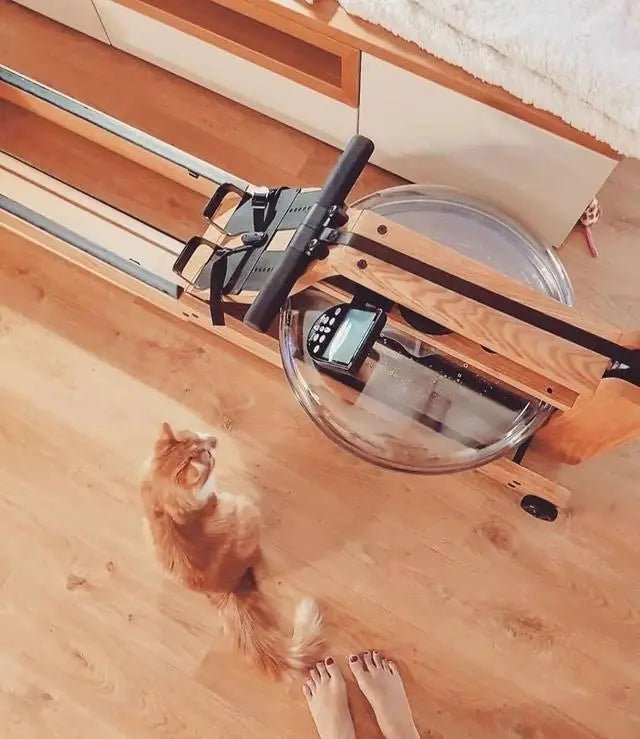Einführung
Ein Wasserrudergerät ist eine ausgezeichnete Wahl, um mit Ihrer Fitness zu beginnen. Wasserrudergeräte sind dafür bekannt, ein Ganzkörpertraining mit geringer Belastung zu ermöglichen und eignen sich perfekt für Personen aller Fitnessstufen. Anfänger stellen sich jedoch häufig die Frage: „Wie verwende ich ein Wasserrudergerät effektiv?“
In diesem Handbuch erfahren Sie alles, was Sie wissen müssen, vom Verständnis der Gerätekomponenten über das Erlernen der richtigen Rudertechnik, das Vermeiden häufiger Fehler bis hin zum Erstellen anfängerfreundlicher Trainingsroutinen. Am Ende haben Sie das Selbstvertrauen und das Wissen, um das Beste aus Ihrem Wasserrudergerät herauszuholen.
Vorteile des Ruderns und das Setzen von Fitnesszielen
Warum Rudern?
Rudern ist eine der effizientesten Übungen, um die Herz-Kreislauf-Gesundheit zu verbessern, Kraft aufzubauen und Kalorien zu verbrennen. Hier erfahren Sie, warum es sich von anderen abhebt:
- Ganzkörpereinsatz : Beansprucht 86 % Ihrer Muskeln, einschließlich Beine, Rumpf, Arme und Rücken.
- Geringe Belastung : Schont die Gelenke und ist daher ideal zur Vorbeugung oder Genesung von Verletzungen.
- Vielseitig : Der einstellbare Widerstand eignet sich sowohl für Anfänger als auch für Fortgeschrittene.
Ziele setzen
Bevor Sie loslegen, legen Sie Ihre Fitnessziele fest. Ob Gewichtsverlust, Muskelaufbau oder allgemeine Fitness – klare Ziele helfen Ihnen, motiviert zu bleiben.
Das Wasserrudergerät verstehen
Schlüsselkomponenten und ihre Funktionen
-
Wassertank und Widerstandssystem
- Der Wassertank erzeugt einen Widerstand, der das natürliche Gefühl des Ruderns auf dem Wasser nachahmt.
- Passen Sie den Wasserstand oder Ihre Ruderintensität an, um den Widerstand zu verändern.
-
Handhaben
- Wird während des Trainings gegriffen, um gegen den Widerstand zu ziehen.
- Sollte sich fest, aber angenehm in Ihren Händen anfühlen.
-
Fußstützen und Riemen
- Sichern Sie Ihre Füße für Stabilität. Stellen Sie die Riemen fest, aber nicht zu eng ein.
-
Schiene und Sitz
- Der Sitz gleitet sanft auf der Schiene und ermöglicht so eine fließende Bewegung bei jedem Hub.
-
Monitor/Konsole
- Verfolgt wichtige Messwerte wie Distanz, Zeit, Schläge pro Minute und verbrannte Kalorien.
Machen Sie sich vor dem Start mit diesen Komponenten vertraut, um eine ordnungsgemäße Verwendung und Sicherheit zu gewährleisten.
Richtige Rudertechnik
Die vier Phasen eines Ruderschlags
-
Der Fang
- Setzen Sie sich mit gebeugten Knien, aufrecht stehenden Schienbeinen, ausgestreckten Armen und geradem Rücken hin.
- Fassen Sie den Griff nur locker an und vermeiden Sie ein zu festes Halten.
-
Der Antrieb
- Drücken Sie durch Ihre Beine, während Sie die Arme gestreckt halten.
- Spannen Sie Ihre Körpermitte an und lehnen Sie sich leicht nach hinten, während Sie den Griff in Richtung Brust ziehen.
-
Das Ziel
- Die Beine sollten gerade sein, der Griff nah am Brustbein und die Ellbogen gebeugt.
- Halten Sie die Körpermitte angespannt und die Schultern entspannt.
-
Die Erholung
- Strecken Sie Ihre Arme nach vorne und beugen Sie Ihre Knie, um in die Ausgangsposition zurückzukehren.
Achten Sie auf fließende Übergänge zwischen diesen Phasen, um ein effizientes Training zu gewährleisten.
Häufige Fehler, die Sie vermeiden sollten
1. Schlechte Körperhaltung
- Fehler : Sie lassen den Rücken hängen oder krümmen.
- Lösung : Halten Sie die Wirbelsäule gerade und spannen Sie Ihre Körpermitte an.
2. Übergriffe
- Fehler : Beim Fangen zu weit nach vorne lehnen.
- Lösung : Halten Sie Ihre Schienbeine aufrecht und vermeiden Sie eine Überdehnung.
3. Falsche Widerstandseinstellungen
- Fehler : Verwendung eines zu hohen Widerstands, was zu Ermüdung oder einer falschen Haltung führt.
- Lösung : Beginnen Sie mit mäßigem Widerstand und steigern Sie diesen allmählich, während Sie stärker werden.
Beispiele für Trainingseinheiten für Anfänger
Training 1: Ausdaueraufbau (15 Minuten)
- Aufwärmen : Rudern Sie 3 Minuten lang in gleichmäßigem Tempo.
- Hauptsatz : Wechseln Sie 10 Minuten lang zwischen 1 Minute moderatem Rudern und 30 Sekunden leichtem Rudern.
- Abkühlen : 2 Minuten lang leicht rudern.
Training 2: Kraft und Leistung (20 Minuten)
- Aufwärmen : 5 Minuten leichtes Rudern.
-
Hauptset :
- 5 Runden mit 1 Minute intensivem Rudern, gefolgt von 2 Minuten langsamem Erholungsrudern.
- Abkühlen : 3 Minuten leichtes Rudern.
Training 3: Ganzkörperfokus (30 Minuten)
- Aufwärmen : 5 Minuten lang gleichmäßig rudern.
-
Hauptset :
- Rudern Sie 10 Minuten lang in gleichmäßigem Tempo.
- Führen Sie alle 3 Minuten 1-minütige Sprints durch.
- Abkühlen : 5 Minuten lang leicht rudern.
Fortschritt verfolgen
Wichtige zu überwachende Kennzahlen
- Distanz : Messen Sie, wie weit Sie in jeder Sitzung rudern.
- Zeit : Verfolgen Sie, wie lange Sie ein gleichmäßiges Tempo durchhalten können.
- Schläge pro Minute (SPM) : Streben Sie für eine effiziente Leistung 18–30 SPM an.
- Verbrannte Kalorien : Überwachen Sie Ihren Energieverbrauch, um ihn an Ihre Gewichtsverlustziele anzupassen.
Verwenden eines Journals oder einer App
Protokollieren Sie Ihre Messwerte nach jeder Sitzung, um Fortschritte zu verfolgen und Verbesserungsbereiche zu identifizieren. Viele Wasserrudergeräte verfügen über eine App-Konnektivität zur detaillierten Fortschrittsverfolgung.
Abschluss
Als Anfänger kann es einschüchternd wirken, die Bedienung eines Wasserrudergeräts zu erlernen, aber mit der richtigen Anleitung wird es zu einer lohnenden und angenehmen Erfahrung. Indem Sie sich auf die richtige Technik konzentrieren, häufige Fehler vermeiden und strukturierte Trainingseinheiten absolvieren, können Sie das volle Potenzial dieses vielseitigen Geräts ausschöpfen.
Letzte Ermutigung
Bleiben Sie konsequent, feiern Sie kleine Erfolge und denken Sie daran, dass Fitness eine Reise ist, kein Ziel. Beim Rudern geht es nicht nur um körperliche Gesundheit – es ist auch eine geistige und emotionale Flucht. Also schnappen Sie sich den Griff, setzen Sie sich Ziele und rudern Sie zu einem gesünderen, glücklicheren Ich!



